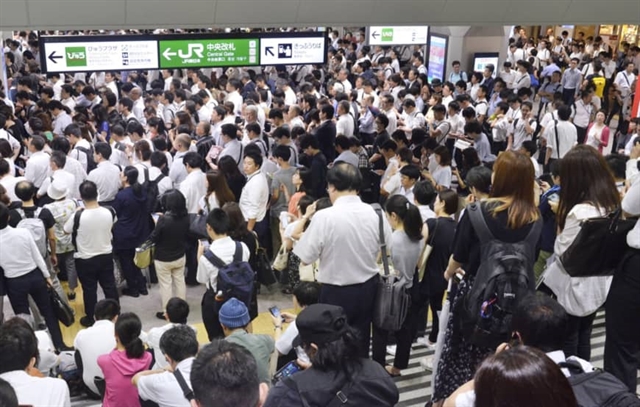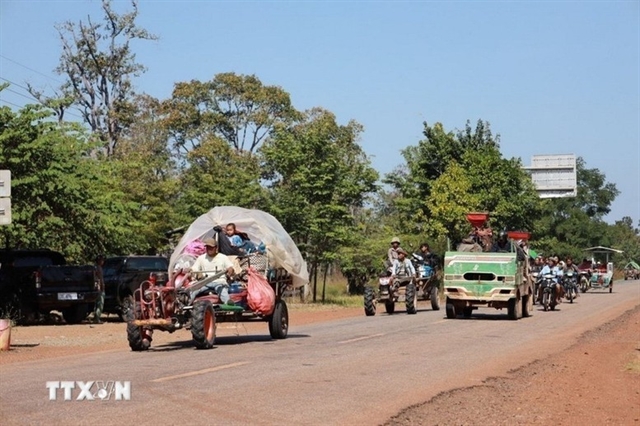 World
World


|
| Commuters waiting for train operations to resume fill Urawa Station in the city of Saitama on Monday morning, after Typhoon Faxai struck the Kanto area earlier in the day causing widespread disruption. — KYODO/VNA Photo |
TOKYO — At least three people have died and more than 50 were injured as a powerful typhoon battered the Tokyo metropolitan area, causing transportation outages that affected nearly 3 million commuters and left thousands stranded at Narita airport east of the capital.
East Japan Railway Co. suspended all train lines in the metropolitan and surrounding areas before Typhoon Faxai made landfall near the city of Chiba shortly before 5am as one of the strongest typhoons known to have hit the Kanto region of eastern Japan.
At Narita airport, an international gateway to Japan, about 14,000 people were stranded on Monday night as the public transportation system connecting the airport and the metropolitan area was suspended, according to Narita International Airport Corp.
Airport officials provided travelers with blankets and crackers. They also passed out sleeping bags to some who decided to spend the night, following a day in which most trains were not running and buses were scarce even after service resumed.
The airport extended its operations by two hours to 1 am on Tuesday. Some international flights of Japan Airlines Co. from Guam and Manila were diverted to Tokyo's Haneda airport due to congestion at Narita.
Many people lined up at train station entrances and counters for shuttle bus services, while other areas in the airport such as food courts were flooded with travelers.
"I was relieved because my flight was not canceled, but I didn't imagine this situation at the airport," said Ryoichi Fukuyama, a 21-year-old college student residing in Tokyo, after arriving from Hokkaido. "I will ask my friend who has a car to pick me up."
Some 930,000 households, mostly in Chiba and Kanagawa prefectures, experienced temporary power cuts, according to Tokyo Electric Power Company Holdings Inc.
A woman in her 50s in Tokyo's Setagaya Ward was confirmed dead after she was blown off her feet and into a wall, while an 87-year-old man died after a tree toppled on him while he was removing fallen trees on a mountain in Otaki, Chiba Prefecture, according to police.
A 47-year-old male civilian who was fixing a power generator at the Maritime Self-Defense Force's Yokosuka base in Kanagawa Prefecture died after apparently falling from a height, the police said. A 17-year-old boy went missing at a beach in Chiba Prefecture as well.
Apparently due to strong gusts, a tall fence surrounding a golf driving range collapsed onto residences in Ichihara, also in the prefecture, leaving a woman in her 20s with serious injuries.
A tree also fell onto an overhead power line between Shinagawa and Osaki stations in Tokyo, and railway crossing equipment was knocked over by winds on the Yokosuka Line, according to JR East.
Winds of up to 209 kilometers per hour were reported on Kozu Island in the Izu islet chain, 207 kph in Chiba city and 156 kph at Haneda airport, all breaking records, according to the Japan Meteorological Agency.
Many vessels were adrift in Tokyo Bay due to strong winds and high waves, leading to collisions involving cargo ships. No injuries were reported in connection with such incidents.
JR East resumed most services later in the day, though delays and disruptions continued as major stations were swamped by commuters and other passengers.
"I was prepared to wait. I'll take whatever line that moves, even if they're not JR lines," said 63-year-old Yukio Sato, who was on his way to work in Tokyo from his home in Yokohama.
Kazumi Kajiwara, 48, said she left her home around 5 am and waited over an hour at Yokohama Station so she could get to work as quickly as possible.
At noon Sunday, the train operator announced ahead of the typhoon's arrival that services for the following day might be canceled given the expected major impact of the storm and the time needed to check the status of lines before restarting operations.
It was the second time JR East has preannounced a suspension in services ahead of a typhoon, after first doing so on September 30 last year.
As the season's 15th typhoon passed eastern Japan, warm air from the south accompanying the storm pushed up temperatures across the Japanese archipelago.
Mercury climbed to 37.9 degrees Celsius in Kuwana, Mie Prefecture, marking a season-high for the central Japan city. Tajimi in nearby Gifu Prefecture logged 37.6 degrees Celsius.
The power outage forced a Sony Corp. unit to suspend operations at a plant in Kisarazu, Chiba Prefecture, where it produces the PlayStation 4 console.
The Japan Atomic Energy Agency said a defunct cooling tower at its research facility in Oarai, Ibaraki Prefecture, was found collapsed in the morning. No radioactive materials leaked in the incident, it said.
Seven nuclear monitoring posts set up by the central government in Chiba Prefecture began failing to send data on radiation levels from early Monday, apparently due to the typhoon, according to the Nuclear Regulation Authority and the Chiba prefectural government. Six of them had begun functioning again by Monday evening.
In the 24 hours through early Monday morning, the typhoon brought more than 440 millimeters of rainfall to the city of Izu in Shizuoka Prefecture, with as much as 109.0 mm falling in one hour in the early morning. — KYODO




